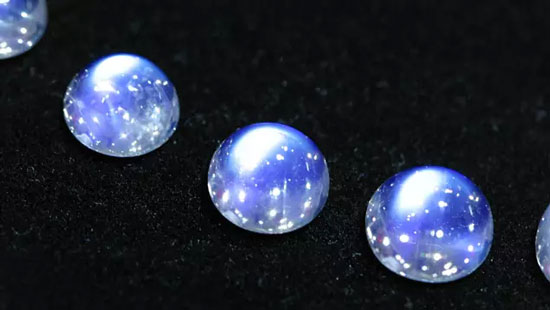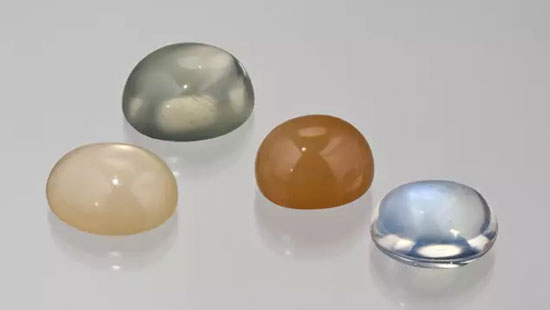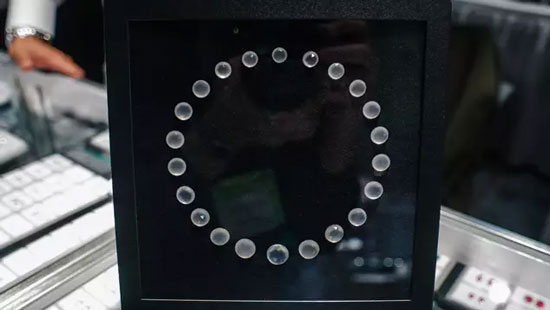The top quality moonstone is embellished with this exquisite platinum and diamond pendant. For centuries, moonstone has fascinated designers and gem connoisseurs. When buyers choose moonstone, they look at three key factors: body color (background color), color, and the direction of the halo. The appearance of moonstone is translucent to opaque, colorless to white, with a blue, silver, or white brilliance effect. Moonstones are widely colored in color, they can be green, yellow to brown or gray to near black. Some moonstones have both brilliance and cat's eye, also known as the cat's eye effect. Some will show four-star starlight, called the starlight effect. colour In the long history, the most popular moonstone should have the following characteristics: colorless, translucent to nearly transparent appearance, no visible inclusions, bright blue and white brilliance, known in the industry as blue light. The top moonstone has the purity of glass with a vibrant blue flash. Moonstone gemstone with blue halo These convex round moonstones show a beautiful blue luster under the multi-directional reflection of the lights in the showcase. The color of the subject should be nearly colorless, without any yellow, brown or unattractive green tones. Ideally, the brilliance of blue and white should be blue. The brilliance should be concentrated on the top of the convex circle, which is clear from all angles of view. If the blue and white brilliance of the moonstone is only visible in a certain range, its value will drop significantly. Moonstone body color Moonstone has a variety of body colors. In 1997, miners in southern India discovered a new species of moonstone, which has a bright green body color and is described in the industry as "budgerigar green." The iconic blue and white brilliance of Moonstone floats in this green sea. Gemstones also exhibit a pale yellow pleochroism, ie different crystal directions show different colors. Today's popular moonstones are diverse in color, with orange to yellow moonstones called peaches. Cleaness A good moonstone is almost transparent, and the less the inclusion, the better. The inclusions will affect the brilliance. Typical moonstone inclusions include tiny tensile cracks known as strontium. It is named because of its similar shape to the long-legged slender creature, 蜈蚣. The most typical moonstone inclusions are stress cracks, which gemologists call "蜈蚣". Cut Moonstone can be used to make beads into beads. But the most common style of cutting is the convex surface. This style best presents its extraordinary phenomena and colors. The convex surface moonstone is usually elliptical. But the cutter sometimes cuts the jewel into a variety of novel and interesting shapes, such as a tapered candy block - an angular circle on the square base. If the moonstone is cut into a convex surface, the dimensions should be uniform and the outline should not be too flat. An overly flat, convex-faced gemstone does not display gloss well and has little value. Faceted moonstone has become more and more common. Cut the union to enhance the brilliance of the gem, while covering up the possible inclusions. Rose-cut moonstone This chic moonstone kit features a rose cut, a cut style commonly used in antique diamond jewelry. Moonstone is often used as a decorative jewellery element and is popular. The “Moon Mid-Autumn†effect of the portrait relief is widely sought after, and its name is also worthy of play. The rugged engraved surface, together with the brilliance of the brilliance, gives birth to a lively beauty, and the jewel color is unpredictable and fascinating. Carat weight Moonstone has a variety of sizes and carat weights. The top quality of large-size stone is becoming scarcer. Moonstone has a wide range of sizes and weights Large and high-quality moonstones are rare and therefore relatively valuable. Jute Braided Rug,Homespice Jute Rugs,Braided Jute Doormat,Natural Braided Rug Hengshui Namei Imp.&Exp. Co.,Ltd. , https://www.nameirug.com

